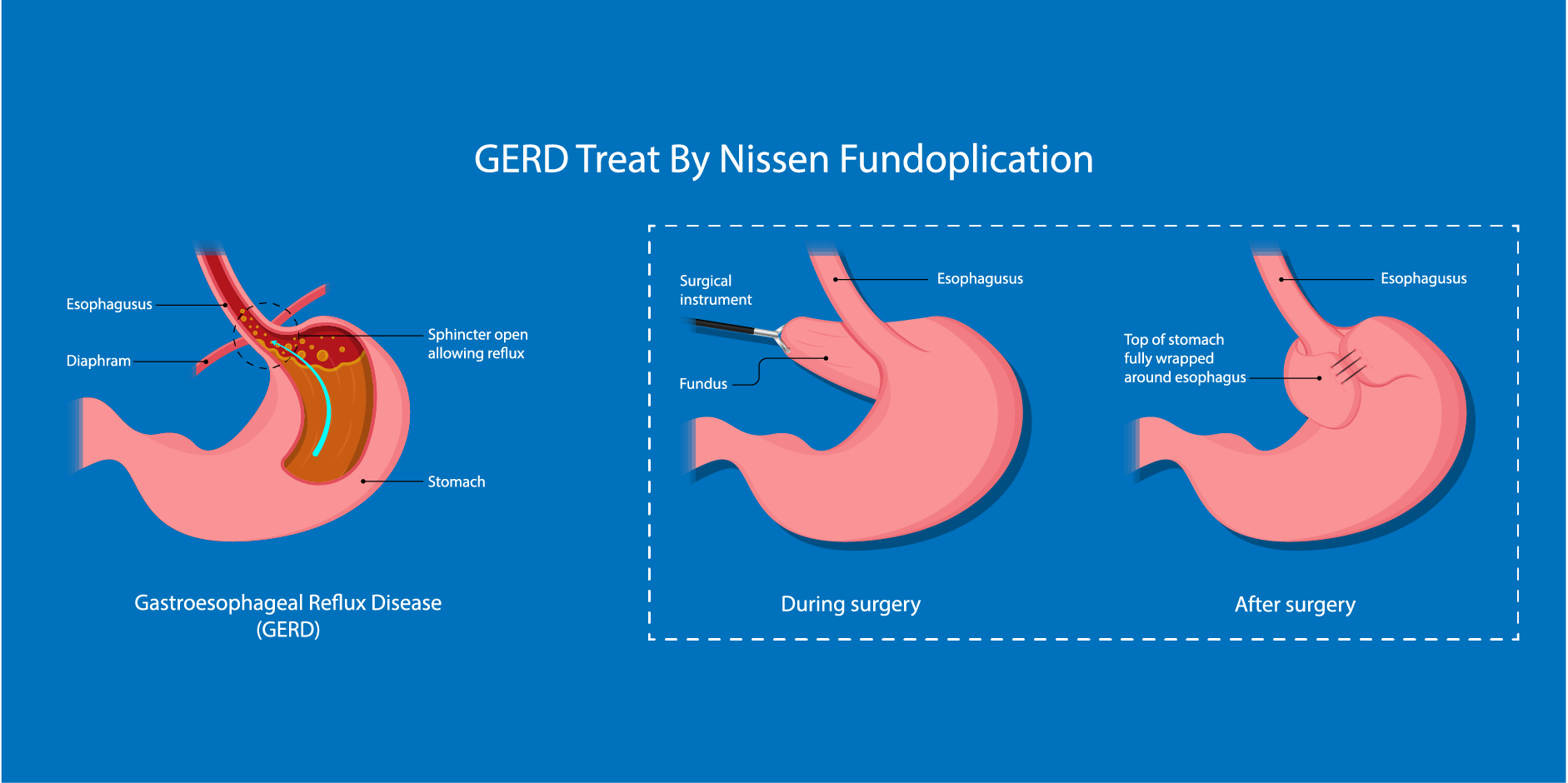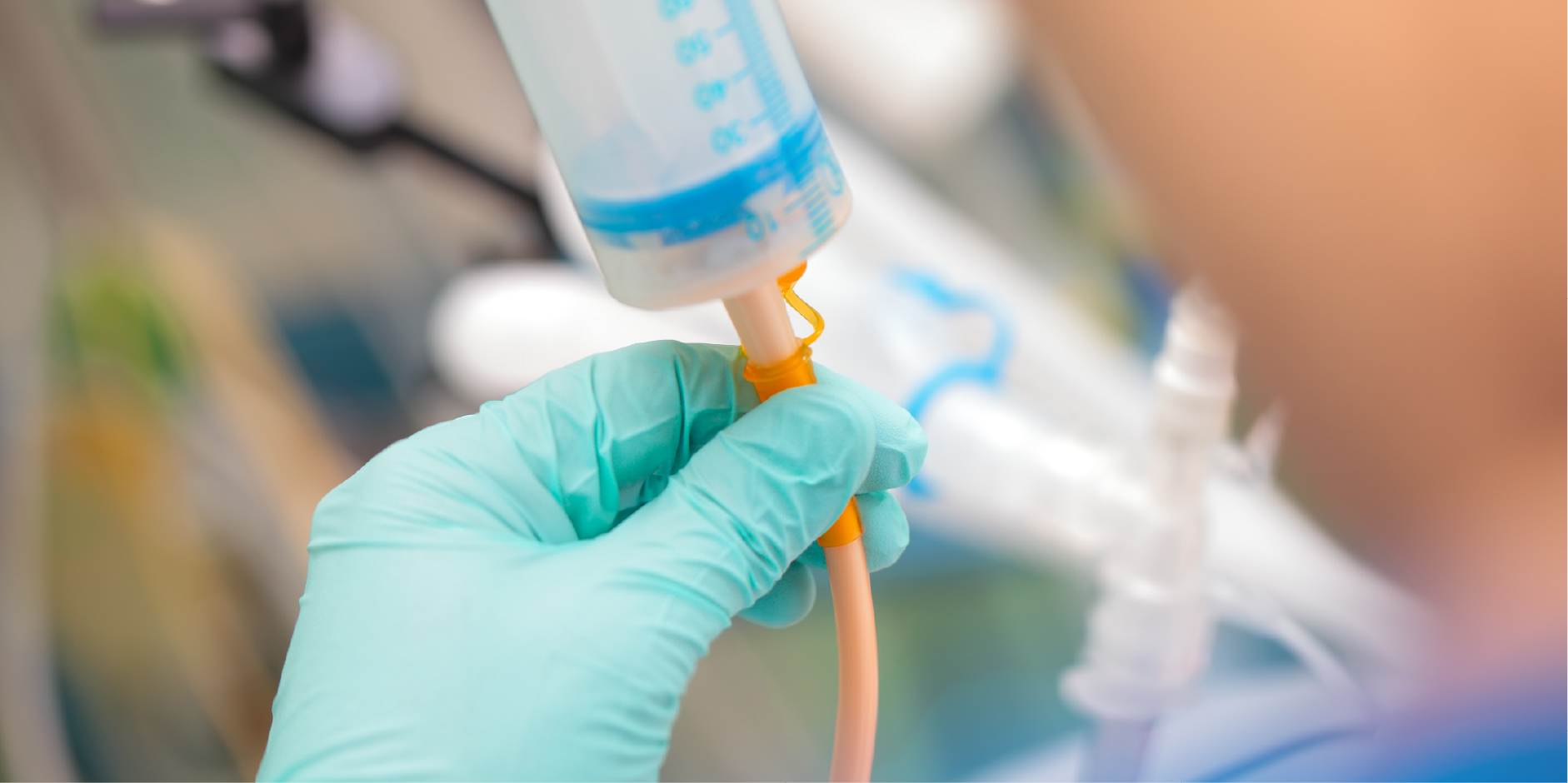Content on this page:
Content on this page:
Principles of Therapy
Conservative
therapy is always the initial management scheme for pediatric patients with
GERD. The 3 steps involved in the management of GERD include lifestyle
modification, acid-suppressive medications, and administration of gastric
protectants (prokinetic agents) to improve transit of stomach contents.
Following PPI therapy, histological exam is recommended to be able to
characterize Barrett’s esophagus and to rule out presence of dysplasia.
The
treatment goals are:
- Relief of symptoms
- Healing esophagitis
- Prevention of recurrence and complications
Pharmacological therapy
Empiric
Therapy
Empiric
therapy is an appropriate initial management for uncomplicated GERD in older
children and adolescents. It is not recommended for infants and young children
with uncomplicated GER. It may be considered in infants whose GER is
accompanied by complications and in cases where non-pharmacologic therapies have
been deemed ineffective. A 4-week trial period is recommended.
Histamine-2
Receptor Antagonists (H2RAs)
Example
drugs: Cimetidine, Famotidine, Nizatidine, Ranitidine
H2RAs
inhibit gastric acid secretion by blocking histamine 2 receptors in the
parietal cells. They effectively reduce gastric pH up to 90% when given 3 times
daily. They also possess therapeutic properties against erosive esophagitis. However,
their use is limited due to tachyphylaxis or tolerance with chronic use.
Proton Pump
Inhibitors (PPIs)
Example drugs:
Esomeprazole, Lansoprazole, Omeprazole, Pantoprazole, Rabeprazole
PPIs demonstrate
superior efficacy compared to other acid suppressants for older children and
adolescents. They can maintain intragastric pH ≥4 longer and inhibit
food-induced acid secretion. They are also able to reduce symptoms and possess
therapeutic properties against erosive esophagitis.They inhibit gastric acid secretion by
blocking the Sodium-Potassium ATPase enzyme activity in parietal cells. Lastly,
their efficacy remains unchanged even with chronic use compared to H2RAs.
Maintenance
Therapy
The
goal of maintenance therapy is to have a symptom-free patient without evidence of esophagitis. The lowest dose and the least potent medication that can obtain a
complete and sustained symptomatic response is utilized. The need for maintenance
therapy is determined by the impact of the residual symptoms on the patient’s
quality of life. The recommended duration of therapy for moderate to severe
heartburn is 2-4 weeks, 4-8 weeks for diagnosed esophagitis, and 3-6 months for
severe erosive esophagitis (followed by repeat endoscopy).
Options
for Chronic Acid Suppression
Step-up
therapy involved starting treatment with less potent agents and escalating to more potent options based on the patient's treatment response. If the patient does not respond to an H2RA
within 2 weeks, switch to a PPI. If the patient does not respond to this
regimen, but there is improvement seen, the dose of the PPI is recommended to
be increased. Other therapeutic options may be considered in PPI-resistant GERD
such as switching to a different PPI, changing the medication time, or adding a
prokinetic agent or an H2RA at night. If the patient is still
unresponsive to the above regimens, the patients’ symptoms are likely not
secondary to reflux and would warrant diagnostic testing and referral to a
pediatric gastroenterologist.
Step-down
therapy makes use initially of a potent acid suppressant, then decreasing the
dose or switching to less-potent agents. The PPI dose should be tapered for at least 4
weeks, after which H2RAs may be considered
to manage rebound symptoms. This is then followed by stepping down further to on-demand
use of antacids if the patient was asymptomatic while taking an H2RA.
Adjunctive
Pharmacotherapy
Antacids
Example
drugs: Aluminum hydroxide, Bismuth salicylate, Calcium carbonate, Magnesium
hydroxide, Sodium bicarbonate
Antacids
neutralize gastric secretions in the gastrointestinal tract. However, long-term
antacid therapy is not recommended in pediatric patients.
Prokinetic
Agents
Example
drugs: Baclofen, Bethanecol, Cisapride, Domperidone, Eryhtromycin,
Metoclopramide
Prokinetic
agents serve as alternative treatment and are not for routine use in patients
with GERD. Cisapride increases gastric emptying time and helps improve
esophageal and intestinal peristalsis. This drug significantly reduced RI but
efficacy for symptom control is not established. It must be noted that the need
for Cisapride therapy should be weighed against its adverse effects (eg
QT-interval prolongation, ventricular tachycardia, ventricular fibrillation)
before initiating therapy. Antidopaminergic agents (eg Domperidone,
Metocloparmide) help facilitate gastric emptying and RI, reducing symptoms
in infants with reflux. Bethanecol, a quarternary ammonium sympathomimetic, has
been used as an alternative treatment for GERD but efficacy and safety are yet
to be proven. Baclofen, a γ-amino-butyric acid (GABA) receptor agonist,
possesses functions that reduce the time for gastric emptying. Studies have
also shown that Baclofen may also decrease emesis frequency. Erythromycin is
another treatment option that may be considered to reduce the time for gastric
emptying. However, it must be remembered that further studies are needed to
prove the efficacy of prokinetic agents for the treatment of GERD in children.
Surface
Protective Agents
Example
drugs: Alginate, Sucralfate
Surface
protective agents are treatment options against mucosal erosions. However, they
are not recommended as monotherapy for GERD. Alginate may be used for
formula-fed infants to help thicken liquid preparations during feeding. It is a potential treatment
option for weakly acidic or non-acid infant reflux.
Management
Based on Symptomatology
There
is no gold standard for the diagnosis of GERD. The duration of treatment with
PPIs or H2RAs depends on the patients’ symptoms.
Regurgitation
and Vomiting
A
thorough history and physical examination may be sufficient to distinguish uncomplicated
from complicated GER in infants and children with recurrent regurgitation. Infants
with recurrent regurgitation but with poor weight gain should undergo thorough
history and physical exam with laboratory examinations (eg CBC, serum electrolytes,
BUN, serum creatinine) to rule out other possible etiologies of the symptoms.
Dietary
modifications (extensively hydrolyzed formula, amino acid-based formula) to
test for cow's milk allergy may also be considered. Infants in unexplained
state of distress with constant crying bouts should be investigated for
diseases other than GERD, as reflux is not a common cause for these symptoms.
Heartburn
Conservative
therapies (eg lifestyle changes, avoidance of trigger factors) are encouraged
prior to initiation of drug treatments. PPIs may be given for 2-4 weeks to test
for responsiveness to this treatment and for patients with moderate to severe
heartburn. Gradual discontinuation of PPI and continuation of conservative
therapies are recommended after positive results with PPIs. As needed use of
PPIs, antacids, and H2RAs may also be considered for symptomatic
relief.
Reflux
Esophagitis
Three
months of PPI therapy is recommended as initial therapy in patients with
erosive esophagitis. The dose may be increased if the patient is unresponsive
after 4 weeks. Endoscopic monitoring may be used to assess treatment response
in patients with atypical signs and symptoms, persistent symptoms despite
appropriate therapy, or those with esophageal stricture or moderate to severe
esophagitis. Long-term PPI therapy or surgery may be considered for chronic or
relapsing reflux esophagitis.
Dysphagia
Odynophagia, and Food Refusal
Odynophagia
and dysphagia have been associated with the presence of esophagitis. Feeding
refusal may be related to GER/GERD but further studies are needed to establish
this association. Some studies incorporated abnormal pH probe findings in
infants and children with feeding difficulty, except in infants with excessive
regurgitation. Upper GI barium contrast
radiography is suggested in infants with feeding refusal and/or feeding
difficulty and for older children with dysphagia. Pharmacological therapy may only be considered in patients with
symptoms highly suggestive of GERD.
Apnea
The
presence of prolonged apnea has been associated with acid reflux in premature
infants. Combined esophageal monitoring and MII may help establish a
relationship between the presence of apnea and regurgitation in a patient. Infants
with regurgitation complicated by apparent life-threatening events (ALTEs) may
benefit from milk mixed with thickeners. Pharmacological therapies are not
recommended as symptoms of apnea are most likely to resolve as the child ages.
Reactive
Airway Disease
Studies
have shown that GER may produce airway hyperresponsiveness and airflow
obstruction leading to asthma exacerbation in asthmatic patients. Asthma, in
turn, may be a factor in the development of GERD due to reduced resting LES
pressure. Studies have shown that 60-80% of children with asthma have abnormal
pH or MII findings. PPI therapy may be considered in asthmatic patients with
persistent heartburn or regurgitation.
Recurrent
Pneumonia
Reflux
of gastric contents has been associated with recurrent pneumonia and
interstitial lung disease. Pharmacologic therapy (eg PPI, H2RAs,
prokinetic agents) may be considered in patients with minimal lung disease
associated with GERD and should be advised about the importance of prompt
follow-up. Antireflux surgery should be considered in patients with severely
impaired lung function to prevent further pulmonary damage.
Upper
Airway Symptoms
Upper
respiratory tract manifestations such as chronic cough, hoarseness, sinusitis,
otitis media, and laryngoscopic features (eg edema, erythema, nodularity) have
been linked to the presence of GERD. Other etiologies should be taken into
consideration prior to starting therapy for GERD. Children may undergo
laryngoscopy to rule out possible functional or anatomical abnormalities.
Dental
Erosions
Several
studies have found the association of GERD with dental erosions secondary to
acidic pH exposure. Referral to a pediatric dentist is recommended.
Sandifer
Syndrome
Sandifer
syndrome is a rare disorder associated with GERD characterized by spasmodic
torsional dystonia with arching of the neck, head, eyes, and trunk. Antireflux
medications and specialist referral are recommended.
Barrett’s
Esophagus
The
diagnosis of Barrett’s esophagus should be established prior to therapy.
Following PPI therapy, histological examination is recommended to be able to
characterize Barrett’s esophagus and to rule out presence of dysplasia.
Nonpharmacological
Dietary
Changes
One
may consider switching to milk formula that contains extensively hydrolyzed
protein or amino acid-based formula instead of regular formulas. Maternal diet modification is also encouraged
for mothers of breastfeeding infants. Avoidance of egg and milk intake may be
considered. Thickeners (eg thickening agent, rice cereals, corn starch, carob
bean gum, soybean polysaccharides) may be considered in healthy formula-fed
infants but should be used with caution especially in preterm infants at
increased risk of necrotizing enterocolitis. Carob bean gum (locust bean gum)
thickened formulas may be used as alternative in reducing infant regurgitation
and acid reflux-related symptoms, with studies demonstrating its constantly
high viscosity in milk formula. While wheat, tapioca, corn, rice, or potato
starch may be used but should be cooked carefully in water and added to infant
formula to avoid recurrence of fermentative diarrhea. Thickeners are recommended
treatments for symptomatic non-acid reflux in infants due to their strong
efficacy and safety profile. Small, frequent feedings may
be tried instead of one big meal while ensuring an appropriate total daily
amount of nutrition. Eating before bedtime should also be avoided. Food that
may trigger symptoms in adolescents (eg caffeine, carbonated drinks, chocolate,
mint-containing food, spicy food) should be avoided.
Patient,
Parent, Guardian Education
Positional
Modifications
Infants should be kept in an upright position during feeding. Infants and children should be fully awake when ingesting food. Avoiding meals within 2-4 hours of bedtime is suggested. Additionally, due to the risk of sudden infant death syndrome (SIDS), supine positioning during sleep is recommended for infants until 12 months of age. Placing a child in an infant carrier or car seat in a semisupine position especially after feeding should be avoided to reduce the risk of GER. For children and adolescents, prone or left-side sleeping position and/or elevating the head of the bed decreases GERD symptoms.
 GERD in Children_Management
GERD in Children_ManagementWeight Loss
Weight loss should be considered in older obese children as studies have shown that there is noted improvement in pH profiles in children who lost weight.
Smoking and Alcohol
Smoking cessation and avoidance of alcohol intake are strongly encouraged in adolescents. Exposure to secondhand smoke also increases irritability in infants and should also be avoided.
Surgery
Indications
for Antireflux Surgery:
- Failed medical management
- Noncompliance with therapy
- Medication side effects
- Inadequate symptom control
- Refractory GERD: Persistence of GERD symptoms in compliant patients despite standard treatment or twice-daily dosing of PPI for at least 8 weeks
- Severe erosive GERD or severe GERD complications (eg peptic stricture, Barrett’s esophagus)
- Extraesophageal conditions (eg pulmonary aspiration, asthma, recurrent aspiration related to GERD)
- Other conditions have been ruled out
- Long-term management required
- Patient, parent, guardian preference
- Despite success with medications, may opt for surgery due to cost of medications or life-long need to take acid-suppressive agents
- Should be advised against surgery if symptoms are well controlled on medical therapy
Antireflux Surgery
Antireflux surgery has
evolved from open type to laparoscopic procedure and in recent years, to
transoral incisionless fundoplication. Surgical success is highest in patients
presenting with typical GERD symptoms and demonstrating good response to
treatment with PPI. In considering antireflux surgery, the patients are
informed regarding the risk of long-term PPI therapy after surgery. Esophageal
manometry and ambulatory reflux studies should be done before surgery to rule
out other disorders such as achalasia, nonreflux induced esophageal spasm,
scleroderma.
Fundoplication
Fundoplication involves
either a partial (Toupet or Thal) or a complete (Nissen, 360 degrees) wrap of
the LES with a section of the stomach, thus increasing the LES pressure. Nissen
fundoplication is more commonly performed in children while partial
fundoplication is preferred in patients with more severe disease accompanied by
motor abnormalities. It must be noted that there has been no statistically
significant difference observed in normal children when studies compared
Nissen, Toupet, and Thal fundoplication. However, recurrence rate was lower for
children with neurological disorders who underwent Nissen fundoplication.
Laparoscopic Nissen technique is preferred over open Nissen fundoplication due
to lower morbidity rates, shorter hospital stay, and fewer perioperative
complications. Complications of the procedure include inability to belch and
vomit, persistent dysphagia, postprandial pain, epigastric fullness, bloating,
temporary swallowing discomfort, and intense flatus.
 GERD in Children_Management2
GERD in Children_Management2Total Esophagogastric Dissociation (TEGD; Bianchi’s procedure)
TEGD or Bianchi’s procedure is a surgical alternative for patients with failed attempts at fundoplication or those with severe neurologic disease. This completely eliminates the risk of GERD recurrence. The procedure involves the complete transection of the esophagus from the stomach and the creation of an esophagojejunal anastomosis.
Endoscopic Procedures
Further studies are needed to prove the efficacy of endoscopic procedures as an alternative surgical treatment for GERD in children.
Endoluminal Endoscopic Gastroplication
Endoluminal endoscopic gastroplication is an endoscopic treatment option for GERD involving the creation of numerous folds or plicae in the gastric mucosa below the LES. Recent procedures (eg titanium beads implantation, full-thickness plication) intend to reduce acid reflux episodes or transient LES relaxations and increase LES basal pressure. Studies have shown successful outcomes in patients who have been symptom-free at 1 year post-op, and with recurrence rate as low as 25% at 3 years post-op.
Stretta Procedure
Stretta procedure involves the application of radiofrequency energy around the gastroesophageal junction, with the goal of reducing reflux by creating scars along the lower esophagus. The scarring created serves as high pressure zones and areas where vagal afferent fibers are interrupted.
Enteral Tube Feeding
Enteral tube feeding involves the placement of a nasojejunal or gastrojejunal tube allowing bypass of the stomach during feeding. Enteral tube feeding may be considered if other conditions for poor weight gain have been investigated and/or recommended feeding and medical management has been unsuccessful. Indications include infants, children, and young people who will benefit from the decreased intragastric feeding causing regurgitation or reflux-related pulmonary aspiration; infants with poor weigh gain and faltering growth associated with GERD; and neurologically-impaired children at increased risk for complications post-op. The clinical decision and planning should include an individualized nutritional plan, strategies to reduce duration of enteral tube placement, and anticipation of removal.
 GERD in Children_Management3
GERD in Children_Management3